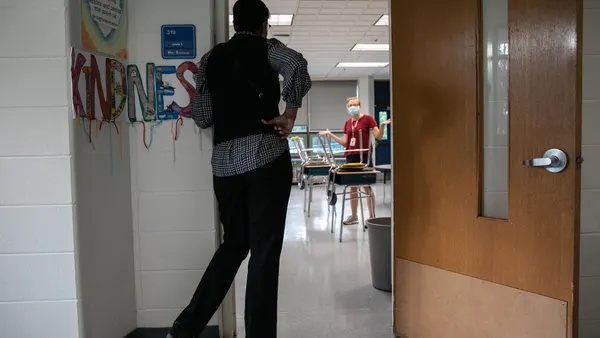Dive Brief:
-
In a Wednesday webinar hosted by Attendance Works and the Institute for Educational Leadership, participants advised schools to use the remainder of this academic year to build programs promoting school attendance and participation so students and families have the supports needed for high engagement this year and next.
-
Strategies such as identifying student populations struggling with absenteeism and using a multi-tiered approach built on positive relationships can help lead to higher attendance rates, as well as opportunities for learning and social emotional supports.
-
Although chronic absenteeism was a problem pre-COVID-19, the changing learning formats and traumatic experiences from the past year have created an even greater need for schools to make this issue a priority, panelists said during the webinar — the first of four this year focused on attendance awareness.
Dive Insight:
The pandemic has made it harder for schools to measure attendance for remote and hybrid learning formats because the data is more difficult to consistently capture and analyze. For example, attendance data collected for remote learners could underestimate the number of children missing out on instructional time.
Because of this, schools will need to reinvent systems of capturing attendance in a way that can be done without much burden on teachers, said Hedy Chang, executive director of Attendance Works and one of the moderators of the webinar.
“There are kids who were chronically absent this year that have not been previously chronically absent, and it is an urgent call for action that we use this data to see who's been hard-hit by the pandemic and needs our resources and supports to turn this situation around and ensure they have an equal opportunity to learn,” Chang said.
An Attendance Works toolkit for COVID-19 Recovery Through Attendance offers four steps to boost pandemic-era attendance.
1. Establish a team: A team of school and district leaders, as well as willing community partners, can develop procedures to identify attendance barriers and inequities, as well as find effective solutions.
School psychologist Chad Swanson and Principal Robert Kraemer, from Warren Street Elementary School in Johnstown, New York, said during the webinar that their school’s attendance team made subtle changes, such as changing the title of "dean of students" to "family liaison," as well as bigger changes like streamlining the way the school communicates with families.
2. Identify priority groups: By reviewing Warren Street’s attendance data, school leaders found 6th grade girls from economically disadvantaged single parent homes had high rates of absenteeism. The school contacted the students’ parents to discuss how the school could support each student’s participation. The students were also paired with a self-chosen staff member at the school who would be in regular contact to encourage participation, Kraemer said.
3. Develop engagement strategies: Shandria Richmond-Roberts, principal of Harrison Pre-K-8 School in Pomona, California, told attendees her school has made several school-wide efforts at engagement, including hosting a picnic.
The school also made individual student interventions, such as visits to students’ homes to help them log into the school’s learning platform. “Now, we're committed to the relationship piece of the school, because with strong relationships we can then build strong academics,” Richmond-Roberts said.
4. Reflect on what’s worked, what didn’t: Several panelists commented on the benefits of teacher-student and student-student mentoring programs. Daisy Sanchez, a senior at Fresno High School in California, is a peer mentor who works with middle school students, students who recently moved from other countries and students having technology challenges. “I want to show them that they can be the student that's there, that's present, that does the work, that's engaged in class,” Sanchez said.
Marcus Strother, president and CEO of MENTOR California, added that mentoring not only provides support for attendance, behavior and academic performance, but also for belonging and school connections.












